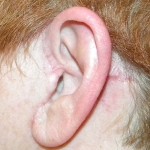Facelift surgery is about improving the neck and jawline at the expense of creating permanent scars. Working the loose skin from the neck up and backwards, excess skin which was once lower on the face is trimmed off around the ears. This ultimately placing the permanent scars in more natural skin creases that exist around the ears.
Many patients understandably are concerned about these scars and how they look through the recovery process until they reach maximal healing. While diagrams and illustrations can show where the scars will be, actually seeing them up close and on a real person is the most informative.

While a facelift produces scars, good incision placement can make them difficult to see. Only the scar behind the ear, where it goes back from the crease into the hairline, can ever be seen. And this is usually reserved for your hairstylist’s eyes only! For men, however, the tail of this facelift scar is changed so it does not go back into the hairline where some men may not enjoy the camouflage of a good hairline and density.
Dr. Barry Eppley
Indianapolis


